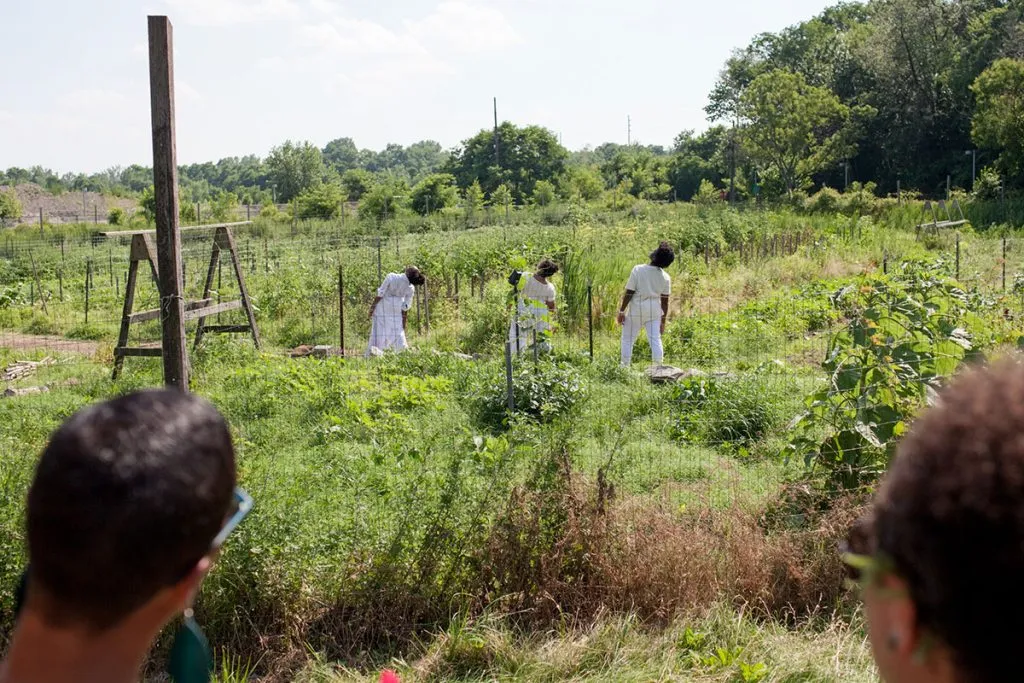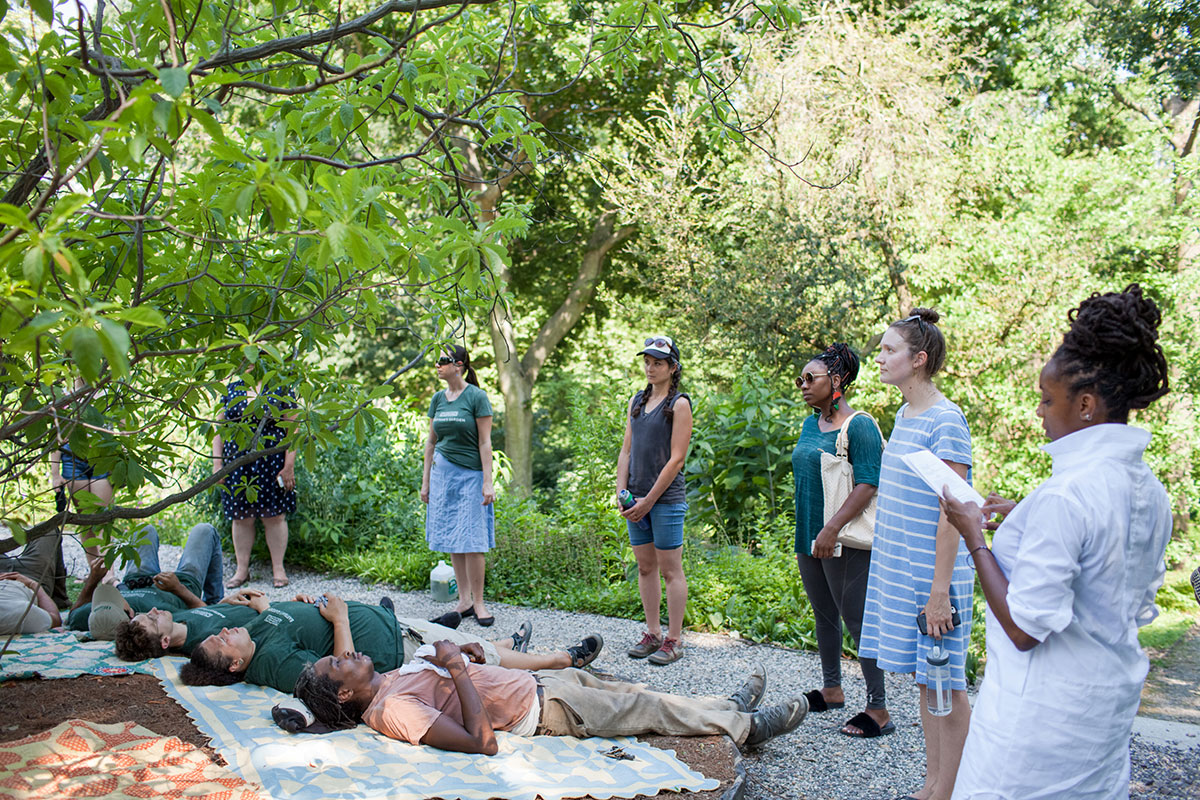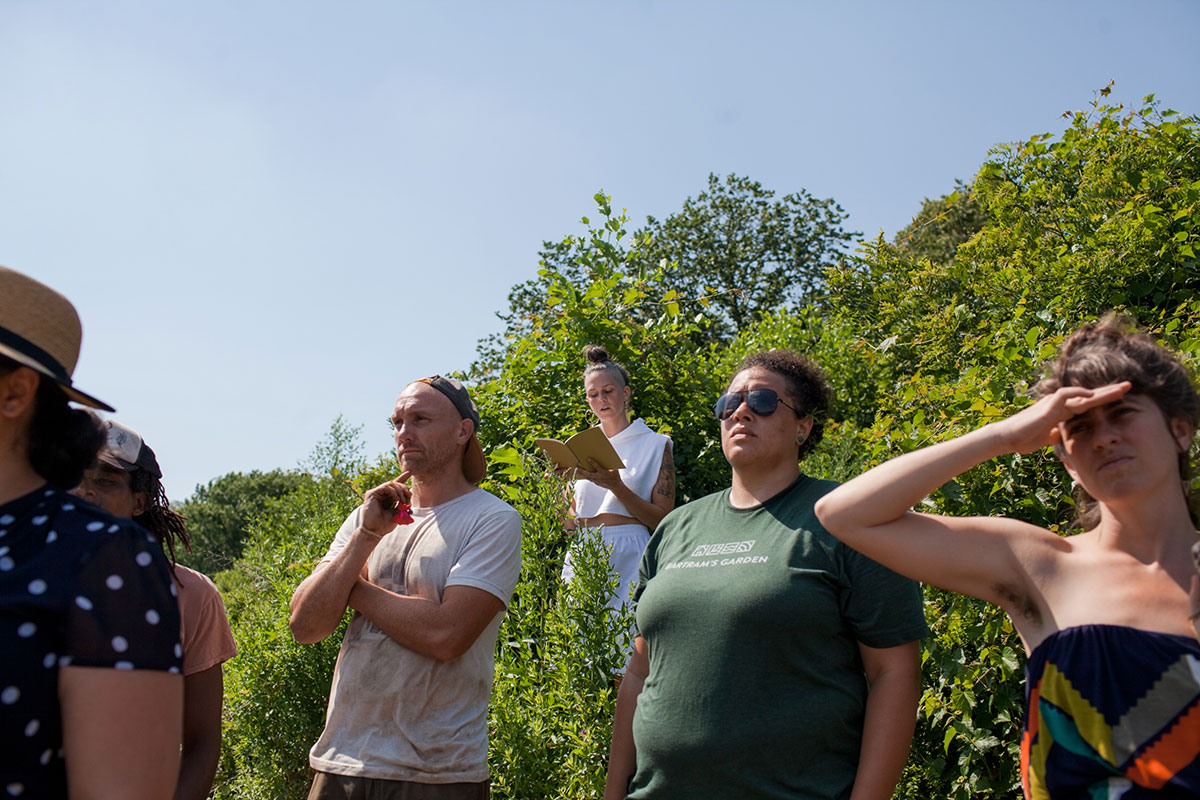Performance Crew BARETEETH on Spatial Justice at Bartram’s Garden

This summer, Bartram’s Garden welcomed BARETEETH, a multi-disciplinary and experimental dance theater collective, as their 2017 Southwest Roots Artist Catalyst. Members include Marie Alarcon, Althea Baird, Darlene DeVore, Lily Hughes, Ash Richards and Jennifer Turnbull. The Artist Catalyst program is a 10-month residency to test innovative approaches and public projects to build connections between the Garden and its neighborhood. As BARETEETH digs in at the Garden, Southwest Roots curator Sarah Schultz asked them a few questions about their hopes for this residency.
Can you talk a little about being a collective of artists from different disciplines?
Jennifer: We are individuals and artists, who have found creative family in one another. We have training in a multitude of skill sets, including dance, music, writing, photography, urban planning, and video, and are self-taught in an avalanche of other ways. We teach each other and hold space for self-discovery in artistic practice and otherwise. Our life experience and the criticism and celebration of those experiences is a thing that brings us together and keeps us creating together. We also connect with other collaborators who have also become creative family over the years.
What interested you in working in Southwest Philly and at Bartram’s Garden?
Althea: Well, we live in Southwest Philly, everyone except Darlene, who moved from Southwest to Delaware. We live here, our kids were born here, we’ve planted trees and watched them grow here, we’ve had friends live and die here. This is the environment we want to be interdependent with. It’s a troubled place to be as a group of transplants in an area that is gentrifying and being colonized. It’s still full of long-term residents—people who remember disinvestment, white flight, and watching the fireworks from the roof of the gypsum factory at Bartram’s Garden. We’ve all been hanging out at Bartram’s for almost 10 years, and because we live here we can do this work on the timeline of friendship, not just the timeline of the grant. Not that we are gonna be able to stay friends with every person that we connect with at Bartram’s, but that’s never how it works anyway. You stay friends with the people that you have need from and for, and that you have desire from and for.

How did you go about getting to know the place and the people here?
Althea: We have spent a great amount of time with people in different settings including teaching dance classes at Bartram’s Village, volunteering at the Sankofa Farm (the neighborhood farm at Bartram’s), participating in the community garden, and being nosey and just talking to people specifically at the playground, neighbor’s stoops, and the horse stables. We have also worked with the staff and students at Woodland Academy and some of our significant relationships were facilitated by Sophia Poe (the Southwest Roots Community Liaison), who already had relationships and connections in Southwest.
Ash: When the residency started, our crew went on a lot of tours, listening deeply to the staff and their knowledge of place and their experiences. Some of those tours were about the Bartram family, and others about the archeology and ecology of the site. As we discussed the staff tours, transcribed interviews, did readings, and conducted research every week, everything began to be intertwined in our understanding of all the interconnected, living, and complex parts associated with Bartram’s Garden and the neighborhood as a place, and we were becoming more deeply a part of it.
How have dance and performance shaped your approach to thinking about place?
Darlene: As dancers and artists, I think we’re constantly seeking—seeking comfort, seeking an energetic pull or a disconnect in the environment. It’s a part of our sensibility as artists. Possibly every place has a power spot, a space for exploration, a place to inspire stillness, to inspire thought, to inspire inquiry, to inspire conversation with word, a movement phrase, a written phrase, or sound or picture, or even simply a feeling. The places we’ve chosen at Bartram’s offer or have offered the possibility for any or all of those sparks of inspiration in seemingly mundane or possibly unappealing environments.

As part of your residency, you created a performative tour of the Garden that you offered specifically to the Bartram’s staff. Can you talk about the tour and how you came up with this idea?
Ash: The idea for the staff tour came when we were all mapping the stories, truths, intimacies of the narratives we were reading about and hearing from staff and neighbors. Our tour looked at the negative space on a map. We wove together the past, present, and future, and placed ourselves and the tour participants in that trajectory. We told and performed stories about workers and ghosts, displaced memories, Black joy and the future of the farm as a Black space, public housing, ecological resistance, and the plantation. Our intention was to guide participants through an experience such as a tour guide would, and to illuminate stories made and left in the gardens, especially those the garden doesn’t acknowledge. We incorporated movement, storytelling, and gifts like roses and mugwort tea in order to broaden the bodily and spiritual witnessing of the stories.
Althea: When we went on all the staff tours, we loved how the procession through the space was like a dance or a site-specific choreography. We picked up on this for our tour. We invited the staff to lie down under the Franklinia tree while they listened to a story about William Bartram’s rice plantation in Florida. We had them look through binoculars across the Lenni Lenape archeological site to see a dance performed on a pier on the other side. A lot of the pieces of the tour were building off information the staff had shared with us in the first place. We expanded on these pieces, both emotionally and historically, making them the center of the tour narrative instead of the margins.

You have a long-standing practice that incorporates spatial justice and the ways that space may confer advantages or disadvantages to certain people. How did this tour help you explore these ideas?
Marie: It’s a guiding framework that we grapple with and even struggle against at times.
Althea: Yeah, maybe what’s most relevant to the tour is actually spatial injustice—seeing how systematic violence is embodied and placed, in human bodies and in bodies of land, plants, animals, etc.
Jennifer: I think that there are complicated and complex connections and histories with and around Bartram’s, with regards to the long-standing residents of the surrounding neighborhoods. When people live in and inhabit a place, it is theirs. A place can be shared and no matter how it is “sanctioned” or mediated, there is a connection that is felt and is real. Historically, the connection of poor people is not honored by those in power and in this country those in power have always been white, in skin color and culturally (Anglo-Saxon, to be specific). Historically, in this country, those who have been brown and Black have always been poor. This history informs and shapes the culture of this country. Therefore, the surrounding neighborhood of brown and Black people are culturally descended from folks whose connections to place have been institutionally stripped over and over and over again during the course of centuries. So while universally, they know the place that they are in is theirs, they also know that in the prevailing colonial way that feeling of connection is not something that is universally honored for them (us).
Marie: People engage with place in really different ways, often in ways that don’t necessarily revolve around the official historical or educational aspects of a space. For example, Bartram’s members who are interested in programming about the historical relevance of John and William Bartram are engaging really specifically. But there’s all these other ways that we have witnessed the park being used that are not about sanctioned programming, and are not about necessarily being interested in those histories. They’re about relaxing, enjoying your family, cutting school, having a birthday party, fishing, drinking by the water, or having bonfires.
Ash: We would also still like to do a Spatial Justice Workshop, where we would explore the continuum of gentrification and neighborhood change as the manifestation of racist capitalism impacting our environment and communities—allowing participants to place themselves in that timeline of systematic violence, resistance, and survival.

Can you give us a preview about the larger, culminating project you are working on?
Marie: We are making a series of videos that showcase some of the folks we met who have an intimate relationship to Bartram’s Garden. We’ve filmed folks in the garden picking tomatoes, kids on bikes doing tricks down Bartram’s Mile, praise dancing, reciting spoken word and rhymes, and caring for their horses. They are filmed in super slow motion at night in the park using a spotlight that brings them in and out of visibility. We will be showing these videos alongside a more traditional documentary that features daytime video and audio interviews with folks we met throughout the residency.
We see this as a kind of mirroring or giving back to folks that we are meeting in the neighborhood. What is their understanding of themselves in the space, in the world, really? It’s not really a documentary about the Garden but gets to a larger questions about how folks that are not seen as participating in natural spaces—park spaces, nature—are actually relating to it. We’re really excited to show these videos!

Southwest Roots is supported by a creative placemaking grant from ArtPlace America, and is a companion project of Art@Bartram’s, a multi-year initiative begun in 2015 focused on the development and production of public art projects in and around Bartram’s Garden, Bartram’s Mile, and the surrounding neighborhood that look to connect the public to the Schuylkill River, raise awareness of water-related environmental concerns, and promote environmental stewardship. This related body of work is supported by the William Penn Foundation.